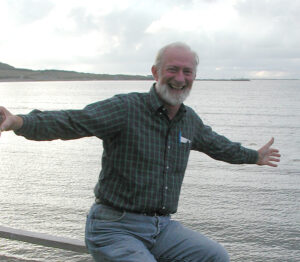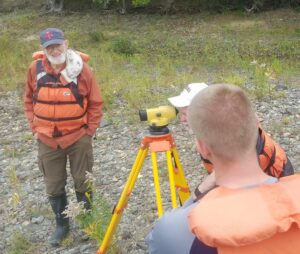Colleagues Commemorate Revered Mentor, Researcher Roger LeBaron Hooke.
University of Maine scientists admired and appreciated colleague Roger LeBaron Hooke, a giant in the fields of glaciology and geomorphology who died March 10, 2021 at age 82.
Hooke, who was born in 1939, moved to Deer Isle, Maine after a distinguished academic and research career. In 2000, during his “retirement,” Hooke became a research professor, as well as a trusted and dedicated adviser in the School of Earth and Climate Sciences (SECS) and Climate Change Institute (CCI) at UMaine.

“We have lost an amazing glaciologist, educator and friend with the recent passing of professorRoger Hooke,” says Paul Mayewski, CCI director. “He will be deeply missed, but his amazing creativity and vigor will always serve as a model.”
Scott E. Johnson treasured Roger’s presence and enjoyed consulting him on matters of research and academic leadership. “I was devastated to hear of his accident and will miss him dearly. He was a wonderful friend and colleague,” says the professor and director of the School of Earth and Climate Sciences.
Alice R. Kelley worked in an office adjacent to Hooke in the Bryand Global Science Center. “I was justifiably intimidated by having a legendary glaciologist and geomorphologist as a ‘next door neighbor,’” says the Golden Undergraduate Coordinator, CCI associate research professor, and SECS instructor.
“I soon found out that he was generous with his time and insights, and greatly enjoyed the time we spent together in the field and working on the geologic history of the Penobscot River.”
Bill Sneed describes Hooke as a graceful and generous mentor. “He served on my master’s committee and was invaluable in getting me through my Ph.D.,” says the CCI assistant research professor. “No matter how inane my question might be, Roger would take the time to enlighten me. Much of what little I know about snow and ice and ice caps I learned from him.”
Hooke was the first Earth scientist whom Dominic Winski met at UMaine. “When I was an undergraduate, I spent a month working with Roger on his diverse array of original research and I credit Roger for much of the reason that I decided to go into this field,” says Winski, now a CCI and SECS research assistant professor.
Kristin Schild says Hooke was incredibly generous with his time and his willingness to support the next generation of scientists and critical thinkers. “Even in his ‘retired’ years at UMaine, you could just as easily find Roger in Wellies, slogging through mud while leading a geomorphology field trip, as you could find him sitting down with a student deriving equations,” says the CCI and SECS research assistant professor and UMaine Arctic coordinator.

“Roger was always ready with a smile and a friendly hello at every hallway passing, and I consider myself beyond fortunate to have known and learned from such an exemplary individual.”
Seth Campbell says having Hooke virtually in an office next door, always willing to help answer challenging questions as an expert in two fields — glaciology and geomorphology — was a gift for him and others at UMaine.”Roger literally wrote one of the top books in our field of glaciology. He had an open-door policy and I recall many visits to his office with questions. Without hesitation, Roger would dig in to help sort through any question of the day. Today, his glaciology textbook remains perpetually open on my own desk as a resource and reminder of what Roger shared with us all,” says the CCI and SECS assistant professor.
Hooke’s scientific paper on sediment movement in meandering rivers was one of the first such papers that Sean Smith read. “I was so pleased to meet him when I arrived at UMaine and was invited on his class field trip,” says Smith, an associate professor in the SECS and Sen. George J. Mitchell Center for Sustainability Solutions.
“Roger was steadfast in his grounding in the fundamental scientific principles of Earth surface process evaluations, and framed his own way of contributing to broader discussions about Earth sustainability solutions by quantifying the role of humans as agents of landscape changes. He leaves us with wonderful science contributions and examples of how to stay true to the principles while informing others about how the planet works and how we affect it”.
At UMaine, one of Hooke’s interests included examining what glacial landforms in Maine revealed about the Laurentide Ice Sheet.
For decades, Hooke was fascinated by landforms. In his biography on the CCI website, he wrote of growing up in Montclair, New Jersey on a strike slope of a Triassic basalt sill, which he loved exploring. Hooke became interested in geology while pursuing a bachelor’s at Harvard University, and became enthralled with research and discovery while earning a doctorate at the California Institute of Technology.
In the 1970s, Hooke studied the genesis of glacial landforms. For years, he conducted research on Barnes Ice Cap on Baffin Island in Canada, focusing on the mechanics of moraine formation at the margins of polar ice sheets, as well as on the ice sheets’ temperature distribution and mechanics of deformation.

In the 1980s, Hooke turned his attention to processes at the glacier-bed interface in Storglaciären — a polythermal valley glacier in northern Sweden. While directing the Tarfala Research Station on Mt. Kebnekaise, he simultaneously held a faculty position at the University of Minnesota. Several of Hooke’s other teaching posts were at the University of Uppsala, University of Stockholm, and University of Tromsø.
In 1995, he published the first of several papers about human impacts on the landscape and about Earth’s limited capacity to sustainably support the human population.
Hooke received several awards, and published numerous articles and three editions of his book “Principles of Glacier Mechanics”. He was a longstanding member of the International Glaciology Society, the American Geophysical Union, and he was a Fellow in the Geological Society of America. Forseveral years, Hooke was the scientific editor for the “Journal of Glaciology” and chief editor of “Annals of Glaciology.”
Those who wish may make a donation in Hooke’s memory to: Island Heritage Trust in Deer Isle, P.O. Box 42, Deer Isle, ME 04627; or to a fund to be created to support scholarships for graduate students in geomorphology, at the University of Maine Foundation, Two Alumni Place, Orono, ME 04469-5792, or at our.umaine.edu/hooke.

